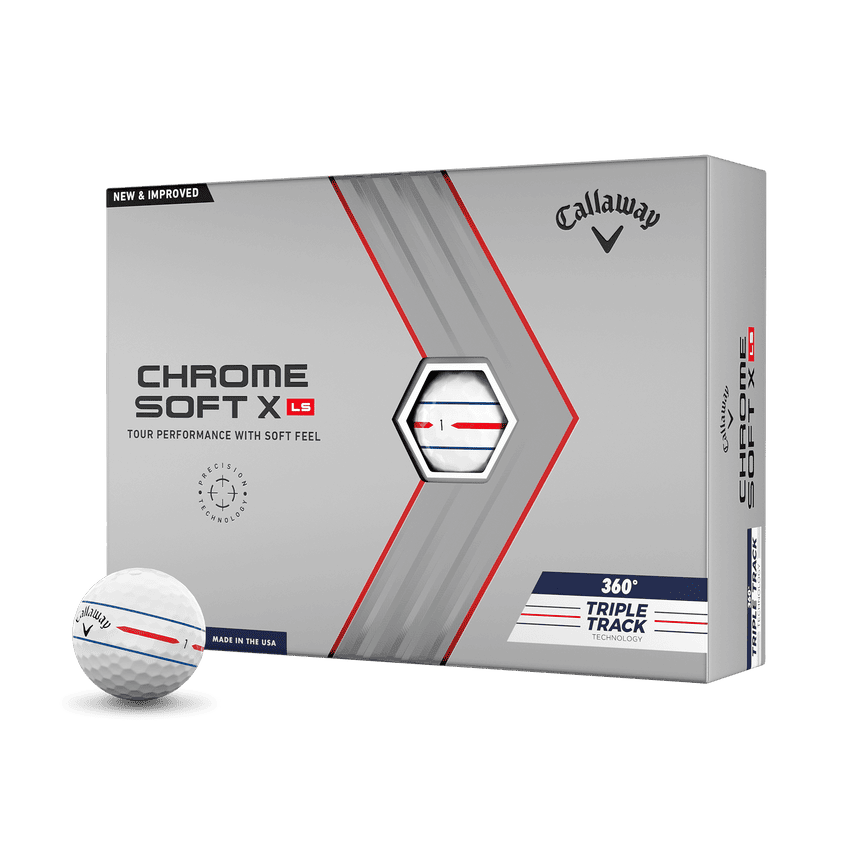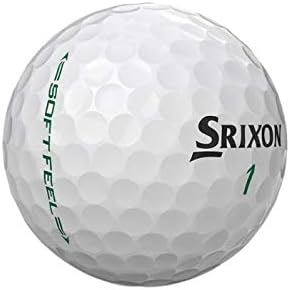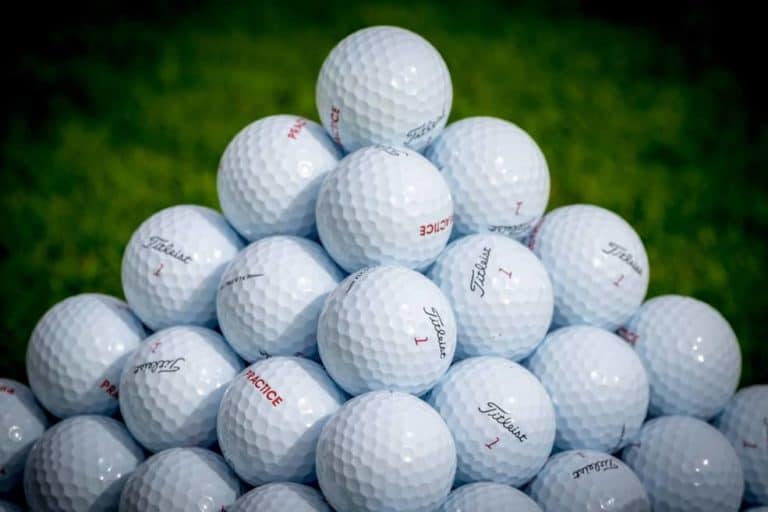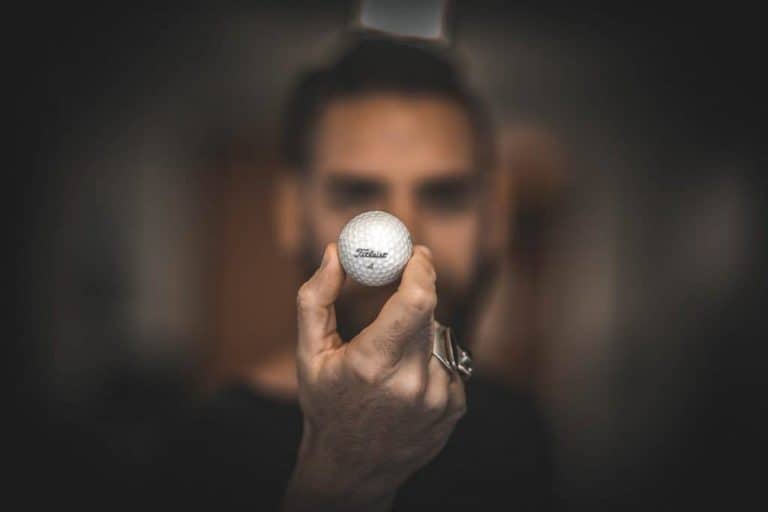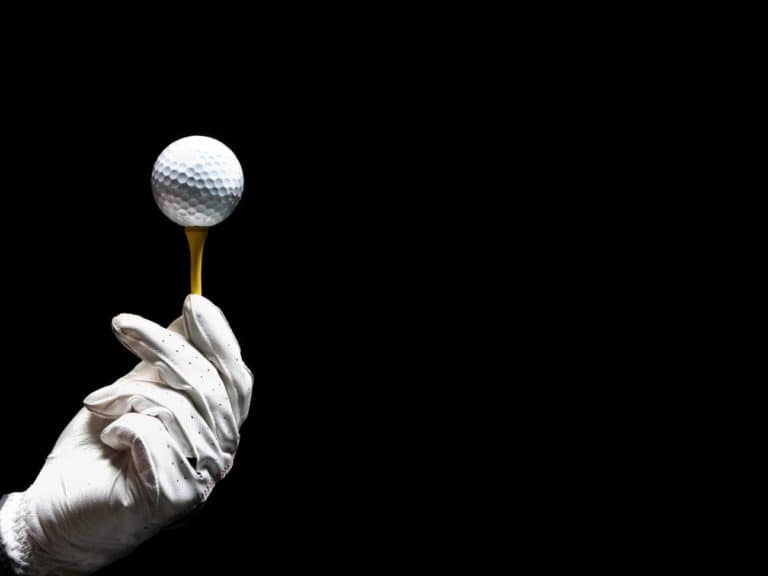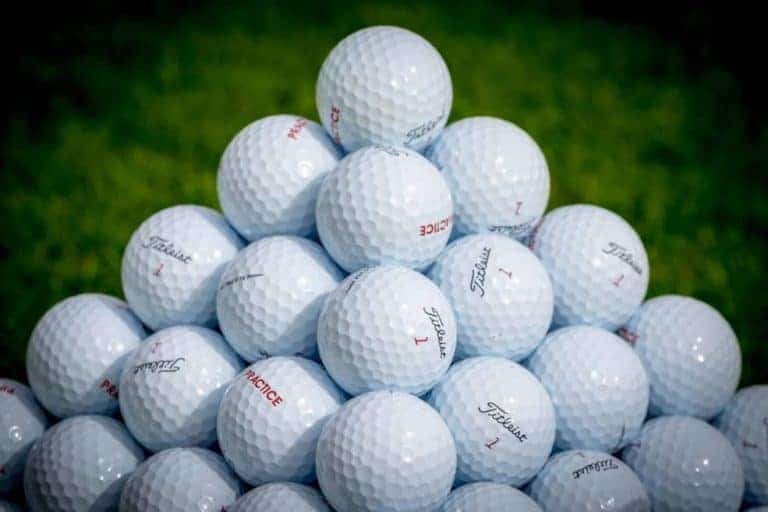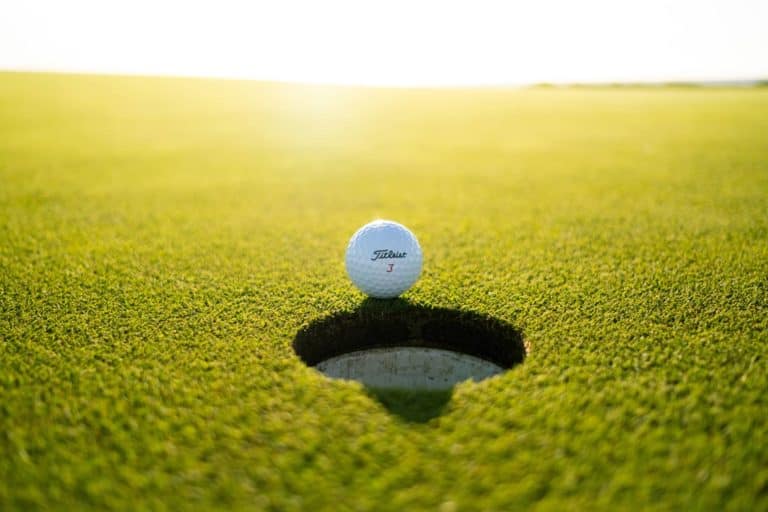Top 10 Low Spin Golf Balls To Transform Your Game
Excessive spin rate is an affliction that affects golfers of all stripes, though the hardest hit tend to be beginning and high handicap golfers. Top symptoms include struggling with accuracy, excessively high launch angle off the tee, and lack of distance from your woods and irons. If that description fits, this post is for you. Let’s take a look at the issues related to creating excessive spin, how switching to low-spin golf balls may help your game right away, review some top options, and answer the most frequently asked questions.
What Are Low Spin Golf Balls?
Low-spin golf balls are specifically designed to minimize the amount of backspin generated during ball flight. Compared to regular golf balls, the low-spin variety is engineered to reduce the spin rate and achieve a more penetrating trajectory through the air.
The construction and design of low-spin golf balls aim to optimize distance, accuracy, and control for golfers who tend to generate excessive spin with their swings. These balls typically have certain characteristics that help reduce spin.
They include:
Core Design: Low spin balls often feature a firmer core compared to regular balls. This helps to reduce the spin of the driver and other long shots. The firmer core promotes higher ball speeds and contributes to lower spin rates.
Cover Material: The cover of low-spin golf balls is usually made from a durable and firm material, such as urethane. This cover composition helps to reduce spin on iron shots and provides control and spin on shorter shots around the greens.
Dimple Pattern: The dimple design on low-spin golf balls is optimized to minimize lift and drag, thereby reducing spin. The dimples are strategically placed and configured to enhance aerodynamics, allowing the ball to maintain a more stable and penetrating flight.
How Can I Determine If I Have My Shots Have A Slow Spin Rate?
Here are a few methods to get an idea of whether your shots have high spin rates:
Ball Flight Analysis: Observing the trajectory of your shots can provide some indications of spin rates. Shots with high spin rates tend to launch at a higher angle, climb quickly, and descend steeply, often resulting in shorter overall distances. They may also show more pronounced curvature, such as hooks or slices.
Shot Shape: Excessive backspin can cause the ball to curve more in the air. If you consistently experience shots that curve excessively (slice or hook), it may indicate higher spin rates. However, shot shape alone is not a definitive measure of spin rates, as other factors like swing path and face angle impact shot curvature as well.
Shot Height: Shots with high spin rates tend to reach higher peak heights. If you notice that your shots have a consistently high trajectory, it could suggest a higher-than-desired amount of backspin.
While these visual cues can give you a general idea, they are not precise measurements of spin rates. For a more accurate assessment, it is recommended to consult with a professional club fitter or golf instructor who can use launch monitor technology to measure your spin rates. Launch monitors provide detailed data on multiple aspects of your shots, including spin rate, launch angle, ball speed, and more.
They can give you precise information about your spin rates and help guide your equipment choices.
How Can Low Spin Golf Balls Benefit Your Game?
Low spin rate golf balls can benefit your game in several ways:
Increased Distance: Low-spin golf balls are designed to minimize backspin, resulting in a more penetrating ball flight and added distance off the tee. With reduced spin, the ball experiences less air resistance, allowing it to carry farther down the fairway.
Improved Accuracy: Excessive spin can lead to shot dispersion and inconsistent ball flight. By using a low-spin golf ball, you can experience better shot control and improved accuracy. These balls tend to produce a straighter ball flight, making it easier to hit fairways and greens consistently.
Better Wind Performance: Low-spin golf balls are inherently more resistant to the effects of crosswinds. With reduced spin, the ball is less likely to be influenced by gusts, resulting in more stable shots even in challenging windy conditions.
Customized for High Swing Speeds: Golfers with higher swing speeds often generate more spin. Low-spin golf balls are typically suited for these players as they help optimize launch conditions by minimizing spin for maximum distance and control.
Better Energy Transfer: Low-spin golf balls often feature a firm core, which facilitates efficient energy transfer from the clubface to the ball. This can lead to higher ball speeds and increased overall distance from players with slower swing speeds.
What Is The Downside In Switching To A Low Spin Golf Balls?
While switching to a low-spin ball can offer various benefits, there are a few potential downsides that should be considered:
Reduced Spin around the Greens: Low-spin golf balls are primarily designed to minimize backspin, particularly on full shots. However, this can also mean that you may experience less spin and control on shots around the greens, such as chips, pitches, and bunker shots. If you heavily rely on the ability to generate spin for certain shots, a low spin ball may not provide the desired level of control.
Limited Shot-Shaping Ability: Low-spin golf balls tend to promote a straighter ball flight and minimize sidespin. While this can be beneficial for accuracy, it may limit the shot-shaping capabilities of those who prefer manipulating the ball’s trajectory and shape intentionally.
Feel Preference: The feel of a golf ball is subjective, and some golfers have a preferred feel when striking the ball. Low-spin golf balls may have a firmer feel compared to other options, which could be a downside for those who prefer a softer feel upon impact.
Swing Speed Considerations: Low-spin golf balls are often optimized for golfers with higher swing speeds. If you have a slower swing speed, the benefits of a low spin ball may not be as pronounced. It’s important to match the ball’s characteristics with your swing speed and playing style.
Cost: Some low-spin golf balls, particularly those with advanced technology and premium materials, can be more expensive compared to regular golf balls. This higher cost may impact your budget or willingness to invest in these types of golf balls.
It’s crucial to assess your playing style, swing characteristics, and personal preferences to determine if the potential downsides of switching to a low-spin golf ball outweigh the benefits. It’s recommended to try different golf ball options, conduct on-course testing, and seek feedback from professionals or other experienced golfers before making a final decision.
What to Look for When Buying Low Spin Golf Balls
When buying a low-spin golf ball, there are several factors to consider. Here’s a guide on what to look for:
Spin Characteristics: Check the ball’s specifications or product descriptions to confirm that it is indeed a low-spin golf ball. Look for terms like “low spin,” “low driver spin,” or “reduced spin.” Manufacturers often market specific models as low-spin options.
Compression: Consider the compression rating of the golf ball. Generally, lower compression balls tend to generate less spin. Golfers with slower swing speeds may benefit from lower compression balls, as they can help reduce spin and optimize distance.
Core Design: Pay attention to the ball’s core design. Low-spin golf balls often feature a firmer core construction, which can help reduce spin off the tee and increase ball speed.
Cover Material: Look for golf balls with a cover made of a soft and durable material, such as urethane. A urethane cover can provide both spin control around the greens and durability for longer shots.
Dimple Pattern: The dimple design on golf balls can significantly impact spin and ball flight. Look for dimple patterns optimized for lower spin rates and better aerodynamics. Manufacturers often mention the benefits of the dimple pattern in their product descriptions.
Feel and Control: Consider the feel and control of the golf ball. Some low-spin golf balls may offer a softer feel, which can be beneficial for improved feedback and control on approach shots and around the greens.
Professional and User Reviews: Read reviews and feedback from professionals and other golfers to learn about their experiences with specific low-spin golf ball models. Their insights can provide valuable information on performance, spin characteristics, and overall satisfaction.
On-Course Testing: Whenever possible, try out different low-spin golf ball models on the course or during practice sessions. This firsthand experience will give you a better understanding of how the ball performs with your swing and playing style.
Consultation: with a golf professional or participate in a golf ball fitting session to find the best low spin ball for your game and goals.
Best low-spin golf balls 2023
Callaway Chrome Soft X LS
The Callaway Chrome Soft X LS golf ball is meticulously crafted for the discerning golfer who places a premium on performance at every turn.
Tailored to meet the needs of players who consistently seek distance and precision, especially when navigating the course from the challenging “tips” tees, this golf ball is designed for those who not only hit long and straight but also possess the artistry to shape their shots with finesse.
With its low spin off the tee, the Chrome Soft X LS maximizes distance while maintaining control, making it the ideal choice for golfers who prioritize accuracy and consistency in their game. Around the green, this ball truly shines, offering high spin and a low launch, ensuring the kind of precise control that can elevate your short game to new heights. Golfers who demand a solid, tour-validated product will find this ball to be the perfect addition to their bag.
Some PGA Tour players who have played with the Callaway Chrome Soft X LS include Danny Willett, Adam Svensson, Akshay Bhatia, Marc Leishman, and Wesley Bryan.
Check pricing on Amazon
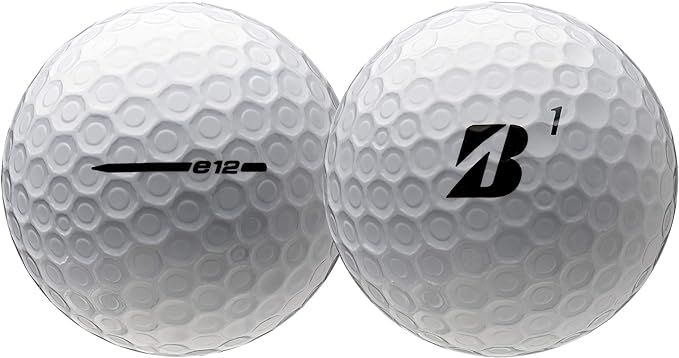
Bridgestone e12
The Bridgestone e12 Contact golf ball offers golfers several key advantages. Its unique Contact Force dimple design enhances the contact between the clubface and the ball, resulting in longer distances off the tee and increased ball speed.
The ball is engineered to reduce sidespin, promoting straighter ball flights and minimizing slices and hooks. Additionally, the e12 Contact features a soft feel and responsive feedback upon impact, thanks to Bridgestone’s Active Acceleration Mantle layer. These selling points make the e12 Contact an appealing choice for golfers seeking improved overall performance, accuracy, and playability.
Pros:
- Straighter Ball Flight: Many users have reported experiencing improved accuracy and reduced sidespin, leading to straighter shots and better control over ball trajectory.
- Increased Distance: The design and construction of the e12 Contact, including the Contact Force dimple pattern, have been praised for generating longer distances off the tee compared to other golf balls in the market.
- Soft Feel: Golfers appreciate the soft feel of the e12 Contact upon impact, which gives them a satisfying feedback and enhances their confidence during shots.
Cons:
- Lack of Spin: While the e12 Contact is designed to minimize sidespin, some golfers who prefer a higher spin rate for better control around the greens may find this ball does not offer as much spin as they desire.
Srixon Soft Feel
The Srixon Soft Feel golf ball offers golfers a combination of distance, feel, and accuracy. Designed to provide a soft and responsive feel upon impact, this ball delivers excellent feedback and control. With its lower compression core and soft cover, it promotes straighter shots with minimized spin for improved accuracy.
The ball’s advanced aerodynamics, achieved through its dimple pattern and design, optimize lift and reduce drag, resulting in longer and straighter shots. Alongside its performance benefits, the Soft Feel golf ball is available at an affordable price point, making it an attractive option for golfers seeking a reliable and cost-effective ball for their game.
Pros:
- Soft feel and great feedback upon impact.
- Long distance off the tee with good carry.
- Improved accuracy, especially minimizing excessive side spin.
- Enhanced aerodynamics for improved flight performance.
- Affordable price point compared to premium golf balls.
Cons:
- Some golfers may find the softer feel less appealing if they prefer a firmer ball.
- May not offer the same level of spin and control as higher-end golf balls.
- Personal preference plays a role in ball selection, and some golfers may find other balls better suited to their game.
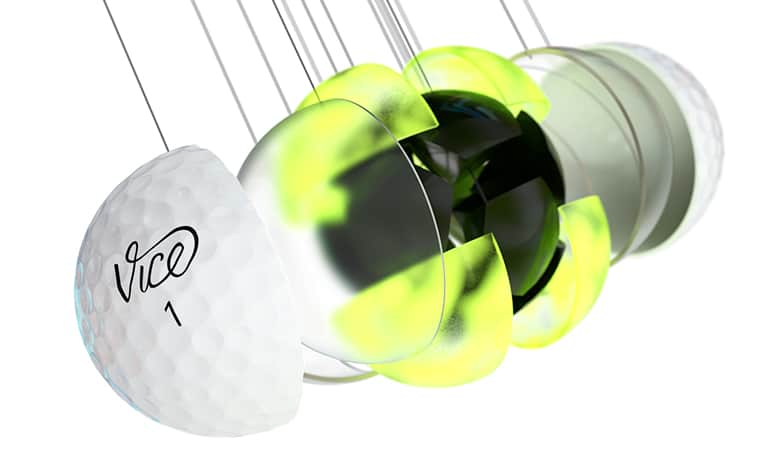
Vice Pro Plus
Vice positions the Pro Plus Golf Ball as a premium product delivering excellent performance at a competitive price point. Its 4-piece construction and dual casing offer enhanced distance and control, particularly benefiting long hitters.
The ball boasts a High Energy Speed Core (HESC), designed to increase ball speed and total distance. Vice Pro Plus also features a Keep In Line (KIL) putt line for superior alignment and targeting, enhancing accuracy on the greens. This product thus promises top-level performance at an affordable cost, aligning with Vice’s distinct direct-to-consumer approach.
Pros:
- Cost-Effective: Vice Pro Plus offers premium performance at a more affordable price point.
- Distance and Control: Many reviewers note the excellent distance and control provided by the Vice Pro Plus.
- Durability: The Pro Plus is often praised for its resilience and durability, retaining performance over multiple rounds.
- Lower Spin: The lower degree of spin lets players have better control over their shots.
Cons:
- Feel: Some golfers might find the feel of the Pro Plus off-putting; the ball feels firmer than some comparable premium balls on the greens.
- Consistency: Some users have reported inconsistency between balls within a box, but this seems to be a relatively rare issue.
- Availability: Due to Vice’s direct-to-consumer model, the products are not readily available in physical stores for trial before purchase.
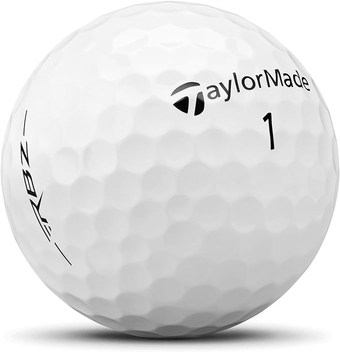
TaylorMade Rocketballz Speed
TaylorMade’s Rocketballz Speed golf ball promises a significant increase in speed and distance thanks to its SpeedMantle with HFMq technology. Alongside this, the ball offers remarkable greenside spin control for precision shots in various conditions. What’s more, the Rocketballz Speed golf ball has a high-quality Iothane cover, blending durability with a soft, responsive feel. Golfers can thus expect the advantage of a golf ball manufactured to withstand prolonged use without compromising the hands-on experience.
Pros:
- Superior speed for enhanced distance.
- Excellent greenside control for precision shots.
- Durable cover for prolonged use.
- Soft, responsive feel for improved shot sensation.
Cons
- May not be suitable for golfers who prefer a lower ball flight.
- Premium pricing could be a barrier for some golfers.
- Balancing speed and control may require adjustment for certain player styles.
Top Related Questions
Does Pro V1 or Pro V1x spin more?
the Titleist Pro V1x generally spins more than the Pro V1. The Pro V1x is designed to offer higher ball speed and lower spin off the tee while providing more spin and control on approach shots and around the greens compared to the Pro V1.
The Prov1x has less firmness, which helps generate slightly less spin at greens and at approach shots. If you play faster swing speeds then it might not be visible as your swing speed needs to be increased to benefit from more spin rates.
What are the benefits of higher spin?
Here are a few benefits of higher spin in a golf ball:
- Control: Higher spin allows golfers to have more control over the ball’s trajectory and direction. With increased spin, players can better shape their shots and make the ball stick to the greens more effectively. This is particularly important for skilled golfers who want to execute specific shot types, such as hitting a fade or a draw.
- Stopping power: When a golf ball has a higher spin rate, it tends to generate more backspin when it hits the green. This backspin creates lift and helps the ball come to a stop more quickly after landing. It can be advantageous in situations where golfers need to carry the ball over obstacles or when aiming for precise landing spots on the green.
- Greenside control: For short game shots around the green, higher spin can be beneficial. The increased spin allows golfers to put more spin on the ball, allowing for better control of the ball’s roll and bounce on the putting surface. This acts as an aid in executing delicate shots like chipping, pitching, and bunker shots.
Ideal spin characteristics of a golf ball can vary depending on a golfer’s skill level, playing style, course conditions, and personal preferences. To optimize their performance, golfers may choose golf balls with spin properties that align with their individual needs.
What is a good spin rate for a driver?
A good spin rate for a golf driver can vary depending on several factors, including the player’s swing characteristics, launch angle, and desired ball flight. In general, a lower spin rate is desirable for longer drives because it helps to maximize distance by reducing the amount of spin-induced drag on the ball.
For professional golfers, an optimal spin rate is typically around 2,000 to 3,000 revolutions per minute (rpm) for a driver. However, for amateurs or recreational golfers, slightly higher spin rates may be more common due to differences in swing speed and technique.
How do you hit irons with less spin?
To hit golf irons with less spin, you can follow these tips:
- Adjust your ball position: Move the ball slightly farther back in your stance. Placing it closer to your back foot can help reduce spin.
- Use a lower lofted club: Using an iron with a lower loft can decrease the amount of spin generated at impact. For example, using a 7 iron instead of a 9 iron can result in less spin.
- Ensure a descending strike: Aim to strike the ball with a slightly descending blow to minimize spin. This can be achieved by positioning the ball slightly ahead of center in your stance.
- Maintain a controlled swing tempo: Avoid excessive acceleration through impact. A smoother swing can help reduce spin.
- Check your grip: Ensure a proper grip without excessive tension. Holding the club too tightly can lead to increased spin.
- Opt for a softer ball: Consider using a golf ball designed to reduce spin. Softer balls tend to generate less spin off the clubface.
- Practice with a professional: A golf instructor can analyze your swing and provide personalized guidance for reducing spin. They can help identify any flaws and offer specific adjustments to optimize your swing.
Remember, reducing spin requires practice and experimentation. It’s important to find the right combination of adjustments that work best for your swing.
Does backspin make a ball go farther?
Backspin can have both positive and negative effects on the distance a golf ball travels. When a golf ball is struck with backspin, it creates aerodynamic lift, which helps keep the ball in the air longer and can contribute to greater distance. Backspin also allows the ball to stop more quickly when it lands on the green.
However, excessive backspin can also cause the ball to balloon in the air and lose distance. This typically occurs when the ball is struck with a steep angle of attack, resulting in too much spin. Additionally, backspin can be affected by the ball’s design, the club used, and the swing technique.
In general, achieving an optimal amount of backspin for maximum distance requires a balance between the launch angle, clubhead speed, and the strike on the ball. Professional golfers and golf equipment manufacturers focus on optimizing these factors to achieve the desired distance and control.
It’s important to note that numerous factors contribute to the distance a golf ball travels, including clubhead speed, launch angle, ball speed, and quality of strike. While backspin is one of these factors, it should be considered in conjunction with the others to achieve optimal performance.
Does backspin make a ball go faster?
No, backspin does not make a golf ball go faster. In fact, backspin typically slows down the ball’s forward motion. When a golf ball is struck with backspin, it creates an upward lift force and generates more turbulent air around the ball, causing the ball to stay in the air longer and travel a shorter distance than it would if it had no spin or had topspin. The backspin does, however, provide several advantages for golfers, such as increased control, accuracy, and the ability to stop the ball quickly on the greens.
Why does my driver have so much backspin?
There could be a few reasons why your driver has so much backspin. Here are some possible explanations:
Swing Technique: One common reason for excessive backspin is a downward strike angle on the ball. If you are hitting down on the ball with your driver, it can create more backspin. Ideally, you want to achieve a slightly upward strike to reduce the backspin. Consider seeking assistance from a golf instructor or coach to analyze your swing and provide guidance on correcting your technique.
Launch Angle: The launch angle plays a crucial role in determining the amount of backspin. If your driver has too high of a launch angle, it can result in increased backspin. A launch angle that is too low can also generate excessive backspin. It’s important to find the optimum launch angle for your swing, which can be determined by factors such as clubhead speed, loft of the driver, and ball position at impact.
Equipment: Equipment factors, such as the type of driver, loft, and shaft stiffness, can influence the amount of backspin. A driver with a higher loft angle generally produces more backspin. Additionally, the characteristics of your shaft, such as its flex and torque, can affect the spin rate. If you suspect your equipment may be contributing to the excess backspin, it might be worth consulting with a professional club fitter to ensure your driver is properly-suited to your swing.
Ball Type: The type of golf ball you use can also affect the amount of backspin. Some golf balls are designed to produce more spin, while others are engineered for reduced spin. Experimenting with different ball types and finding one that reduces backspin could potentially help address the issue.
Why am I spinning the ball so much?
There can be several reasons why you might be spinning the golf ball excessively with your shots. Here are a few factors that could contribute to increased spin:
Loft and club selection: Using clubs with higher lofts, such as wedges, generally generates more spin. If you consistently use clubs with higher lofts, you can expect the ball to spin more.
Swing speed and angle of attack: A faster swing speed, combined with a steep angle of attack, can create more backspin on the ball. If you have a steep swing plane or tend to swing downward sharply, it can result in increased spin.
Ball contact: Striking the ball with a clean and centered impact, known as hitting the sweet spot, can optimize spin and control. If you consistently hit the ball off-center, the spin may be affected.
Golf ball selection: Different golf balls have varying characteristics, including spin rates. Some golf balls are designed to produce higher levels of spin, while others are designed for lower spin. Analyzing and experimenting with different ball options might be worthwhile.
Swing mechanics: Other swing mechanics, such as a strong grip, excessive wrist action, or an open clubface at impact, can influence spin. Consulting with a golf instructor who can assess your swing mechanics may be beneficial.
How does golf ball spin affect distance and accuracy?
The spin on a golf ball plays a crucial role in both distance and accuracy. Here’s a breakdown of how spin affects these two aspects:
- Distance:
- Backspin: When a golf ball has backspin, it generates lift, allowing the ball to stay in the air longer. This lift counteracts the force of gravity and helps the ball achieve greater carry distance. Backspin also creates a steeper angle of descent, reducing rolling distance upon landing. As a result, shots with more backspin tend to carry farther but roll less.
- Side spin: Side spin can be either a hook (leftward spin for right-handed golfers) or a slice (rightward spin for right-handed golfers). These types of spin can significantly impact distance. Shots with excessive side spin can lead to a loss of accuracy and a decrease in overall distance as the ball veers off the intended path.
- Accuracy:
- Backspin: Backspin helps with accuracy, particularly on approach shots and shots around the green. The backspin allows the ball to have more control and stop quicker upon landing. This enables golfers to better predict where the ball will end up on the green and helps prevent it from rolling too far past the target.
- Side spin: Side spin has a detrimental effect on accuracy. Shots with excessive side spin can cause the ball to deviate from the intended line, leading to shots that miss the target. Reducing side spin can improve accuracy and increase the likelihood of hitting the intended target.
What causes a golf ball to spin, and how can I control it?
A golf ball spins primarily due to a combination of the golf club’s impact with the ball and the aerodynamic forces acting on it during its flight. When a golf club strikes a ball, it imparts both backspin and sidespin.
Backspin is the primary source of spin and is generated when the clubface strikes the ball with a slightly downward and sweeping motion. This imparts a backward spin on the ball, causing it to spin in the opposite direction of its flight. Backspin helps the ball achieve lift, stay in the air longer, and creates a stable trajectory.
Sidespin, on the other hand, is generated when the clubface contact with the ball is not square. If the clubface is open or closed to the target line, it causes the ball to spin sideways, resulting in a hook or a slice.
To control the spin on a golf ball, consider the following factors:
- Clubface angle: Adjusting the clubface angle at impact can influence the amount of backspin. A more downward strike and a slightly open clubface can increase backspin, causing the ball to stop more quickly upon landing.
- Loft: Higher lofted clubs, such as wedges, tend to generate more spin due to the increased friction between the clubface and the ball.
- Ball position: Placing the ball slightly back in your stance can help promote a steeper downward strike, resulting in increased backspin.
- Swing speed: Higher swing speeds can potentially generate more spin. However, this is influenced by numerous factors, and it is important to note that excessive side spin generated by a high swing speed can lead to accuracy issues.
- Quality of contact: Striking the ball in the center of the clubface consistently can promote more backspin.
What are the differences between low-spin and high-spin golf balls?
Low-spin and high-spin golf balls refer to the amount of spin generated when struck by a golf club. Let’s explore the differences between these two types:
- Spin Generation: Low-spin golf balls are designed to produce less backspin when hit, resulting in a flatter trajectory. They tend to reduce the amount of spin imparted on the ball, minimizing side spin and providing increased accuracy. On the other hand, high-spin golf balls generate more backspin upon impact, leading to a higher ball flight and greater spin on approach shots.
- Distance: Low-spin balls are typically designed to maximize distance off the tee. They have a lower spin rate, which means they are less affected by air resistance, providing more roll and carry. High-spin balls, while sacrificing some distance off the tee, offer better control and stopping power on approach shots due to increased spin.
- Control and Feel: High-spin golf balls are often preferred by skilled players seeking maximum control over their shots. The added spin allows for more shot shaping and precision when hitting into greens. These balls also tend to offer better feedback and feel off the clubface. Low-spin balls, on the other hand, may feel firmer and offer less feedback but are optimized for distance and reducing dispersion.
- Playing Conditions: The choice between low-spin and high-spin balls can also depend on the playing conditions. In windy conditions, low-spin balls are often preferred due to their flatter trajectory and reduced susceptibility to side spin caused by the wind. High-spin balls excel in softer conditions, such as greens that hold shots well, where the additional spin can help stop the ball quickly.
How can I reduce spin on my golf shots?
Reducing spin on golf shots can help enhance accuracy and control. Here are a few tips to help you achieve this:
- Adjust Your Grip: A grip that is too tight can contribute to excessive spin. Ensure your grip is firm but not overly tight. Experiment with different grip pressures to find the right balance.
- Ball Positioning: Placing the ball slightly back in your stance can reduce spin. This encourages a more shallow angle of attack and helps promote a lower launch angle with less backspin.
- Swing Tempo: Consider working on your swing tempo. A smoother, more controlled swing can help reduce unnecessary spin. Focus on maintaining a consistent rhythm throughout your swing.
- Loft Angles: Check the loft angles on your clubs. Higher-lofted clubs tend to generate more spin. If you have particularly high spin rates with certain clubs, you might consider getting them adjusted by a professional club fitter.
- Swing Path and Clubface Alignment: An out-to-in swing path or an open clubface at impact can exacerbate spin. Work on ensuring your swing path is more neutral, and the clubface is square at impact. This may help minimize excessive side spin.
- Utilize Lower Spin Golf Balls: Different golf balls offer varying levels of spin. Consider experimenting with lower-spin golf balls, which can help reduce the amount of spin generated on your shots.
- Seek Professional Guidance: If you’re struggling to reduce spin on your golf shots, it can be valuable to consult a golf instructor or club fitter. They can analyze your swing and equipment, providing personalized advice and recommendations to help you achieve the desired results.
Can golf ball spin be adjusted based on swing speed or clubhead speed?
Yes, the spin of a golf ball can be influenced by swing speed or clubhead speed. The amount of spin generated by the ball is primarily determined by the interaction between the clubface and the ball at impact. Faster swing speeds typically result in more spin on the ball.
When the clubface strikes the ball, the angle of approach, the loft of the club, and the speed of the clubhead all play a role in determining the amount of backspin or sidespin that the ball will have. A combination of these factors can lead to different levels of spin.
In general, higher swing speeds tend to generate more backspin, which can help the ball stay in the air longer and result in longer carry distances. Additionally, increased spin can also enhance control and shot shaping for more advanced golfers.
It’s worth noting that the design and construction of the golf ball itself also play a significant role in spin. Golf balls with different dimple patterns, cover materials, and compression levels are designed to promote different amounts of spin, catering to various swing speeds and player preferences.
Therefore, while swing speed or clubhead speed can affect the spin of a golf ball, other factors like angle of approach, loft, and ball design also come into play to determine the final amount of spin that a golfer achieves.
Are there any specific techniques or modifications to my swing that can help reduce spin?
Yes, there are a few techniques and modifications to your swing that can help reduce spin on the golf ball.
- Grip: Adjusting your grip can impact the spin on the ball. A stronger grip, where your hands are rotated slightly clockwise on the club (for right-handed golfers), can help reduce spin. This grip promotes a more controlled release of the clubhead through impact, resulting in less spin.
- Flatten the Swing Plane: A steep swing plane tends to produce more spin. Working on flattening your swing plane can help reduce the spin on the ball. Focus on keeping your hands lower and wider during the backswing, and try to swing more around your body rather than lifting the club vertically.
- Ball Position: Placing the ball slightly further back in your stance can help reduce spin. This encourages a slightly steeper angle of attack, resulting in lower spin rates.
- Smooth Tempo: An aggressive and forceful swing can generate excess spin. By focusing on a smoother and more controlled tempo, you can reduce the amount of spin produced. Practice swinging with a consistent rhythm and avoid overswinging.
- Club Selection: Choosing the right clubs can also play a role in reducing spin. For example, using a lower spinning driver or selecting irons with less loft can help minimize spin rates.
- Impact Position: Proper impact position is crucial in controlling spin. Focus on a downward strike on the ball with a slightly descending angle of attack. This helps produce a more penetrating ball flight with reduced spin.
- Weight Distribution: Shifting your weight slightly more towards your front foot during impact can help decrease spin. This promotes a more solid strike and prevents excess spin from being imparted on the ball.
Is there a recommended spin rate I should aim for depending on my skill level?
The ideal golf ball spin rate can vary depending on several factors, including your skill level, swing speed, and personal preferences. However, there are some general recommendations that can serve as a starting point.
For high-handicap or beginner golfers, a lower spin rate is often advantageous. A lower spin can help reduce the side spin on the ball, making it easier to keep the ball straight and in play. It can also lead to longer shots since less spin generally means more distance.
On the other hand, more skilled golfers, especially those with faster swing speeds, often benefit from higher spin rates. Increased spin can provide better control and workability of the ball, allowing for more precise shot shaping and greater stopping power on the greens.
To determine your ideal spin rate, it would be best to get a professional fitting or consult with a golf instructor. They can assess your swing characteristics, launch conditions, and ball flight to provide personalized recommendations tailored to your specific needs and goals.
How does golf ball spin affect shots in different weather conditions, such as wind or rain?
Golf ball spin plays a vital role in determining the trajectory and distance of shots, and it can be significantly influenced by weather conditions like wind or rain.
Wind:
In windy conditions, the spin on a golf ball can interact with the airflow, resulting in additional effects on the flight of the ball. Here’s how wind affects shots based on spin:
- Headwind: When hitting against a headwind, backspin can help lift the ball higher and reduce the effect of the wind pushing the ball down. This can result in a higher ball flight and potentially more carry distance.
- Tailwind: A tailwind can enhance the distance of shots due to the extra forward push. However, when paired with backspin, the ball can rise too quickly and lose its momentum, causing a balloon-like flight and potentially reducing overall distance control.
- Crosswind: When the wind blows across the intended flight path of the ball, it can create a side force on the spinning ball, leading to a lateral deviation in its trajectory. Side spin can cause hooks or slices depending on the direction of the wind relative to the initial ball’s spin.
Rain:
Rainfall can affect shots by altering the interaction between the clubface and the ball at impact, which can have an impact on spin. However, the specific effects are also influenced by the type and intensity of the rain, as well as the condition of the golf ball.
- Reduced Spin: Wet conditions can decrease the friction and grip between the clubface and the ball at impact. This reduced friction may lower the backspin generated, leading to less lift and shorter carry distances.
- Increased Ball Flight: The moisture on the ball’s surface can cause it to travel through the air with slightly less resistance, resulting in a higher trajectory. This increased ball flight can impact distance control.
- Increased Roll: Rain-soaked fairways can be more receptive to the ball’s landing, resulting in reduced or no rollout after impact. Shots may stick closer to the point of landing instead of rolling as much as they would on dry ground.
Which Spin More, Hard Balls or Soft Balls?
In golf, the spin generated by a golf ball is influenced by various factors, including the type of ball used. Generally, softer golf balls tend to spin more than harder golf balls.
Soft golf balls have a lower compression, which means they compress more upon impact with the clubface. This compression allows the ball to deform and grip the clubface, creating more friction and generating more spin. The increased spin can contribute to better control and stopping power on the greens.
On the other hand, harder golf balls have a higher compression and do not deform as much upon impact. As a result, they have less grip on the clubface, leading to less spin. Harder balls are often preferred for their distance and lower trajectory, but they may offer less spin control around the greens.
Related: Best Golf Balls of 2023


